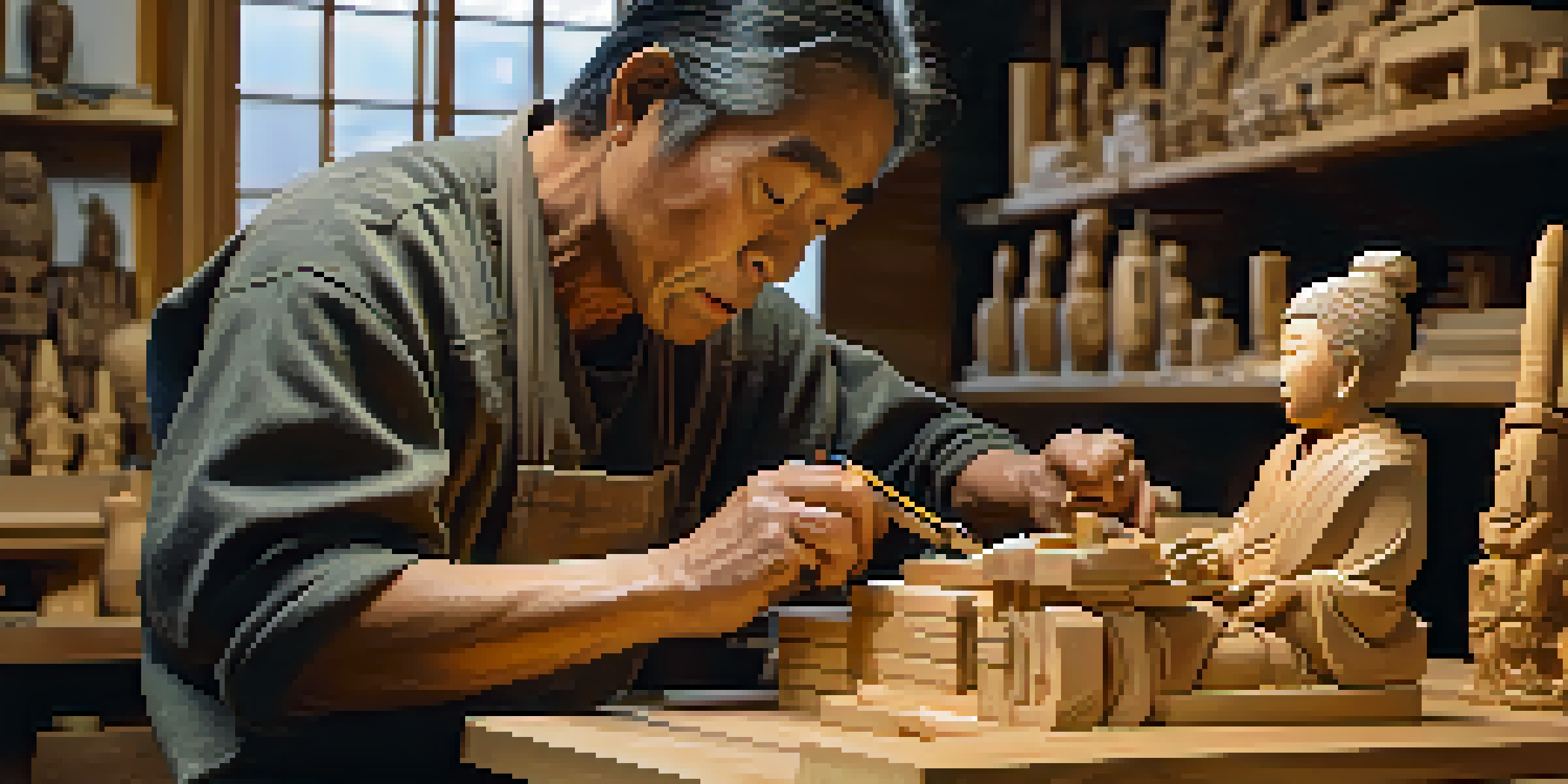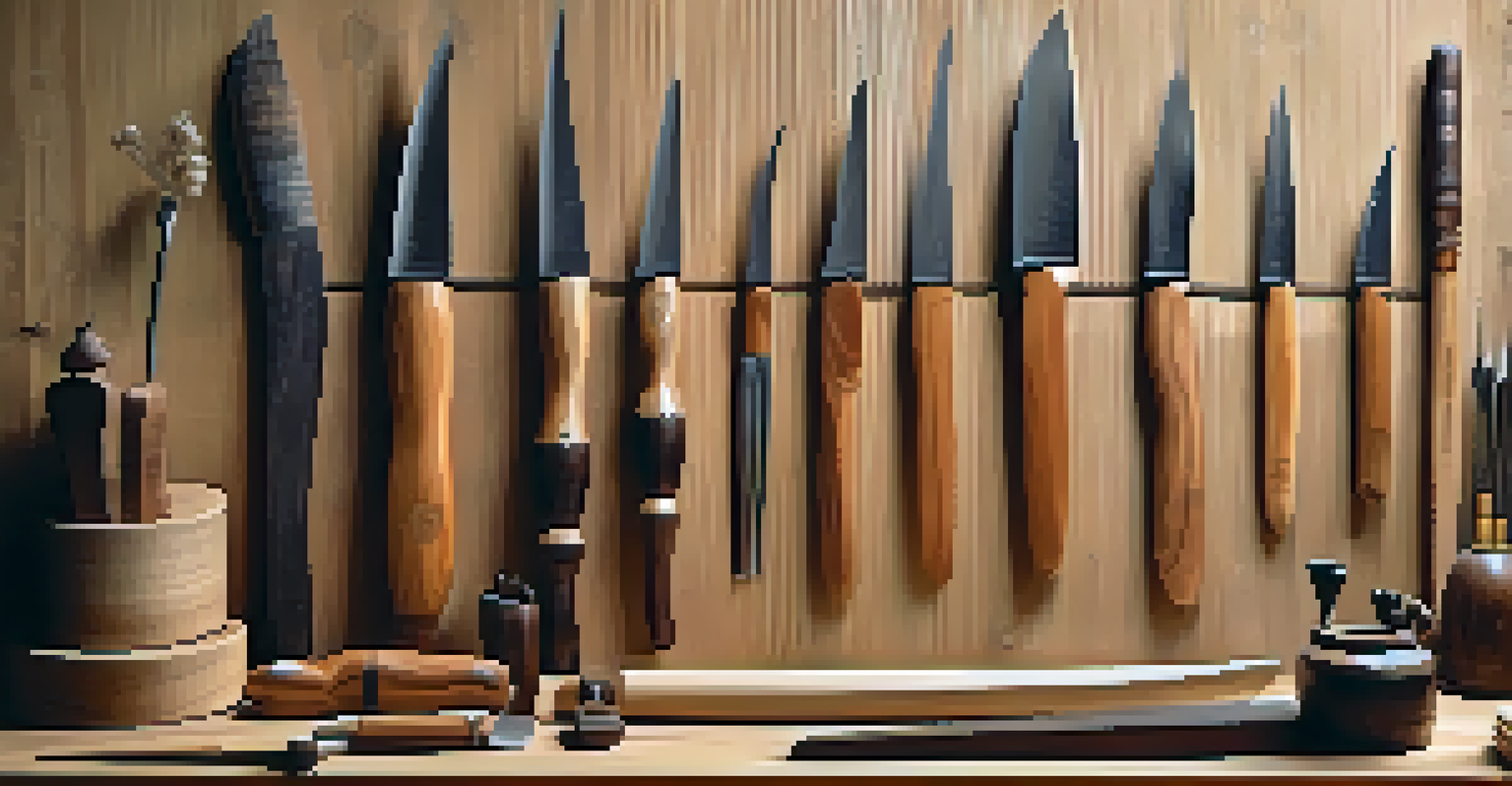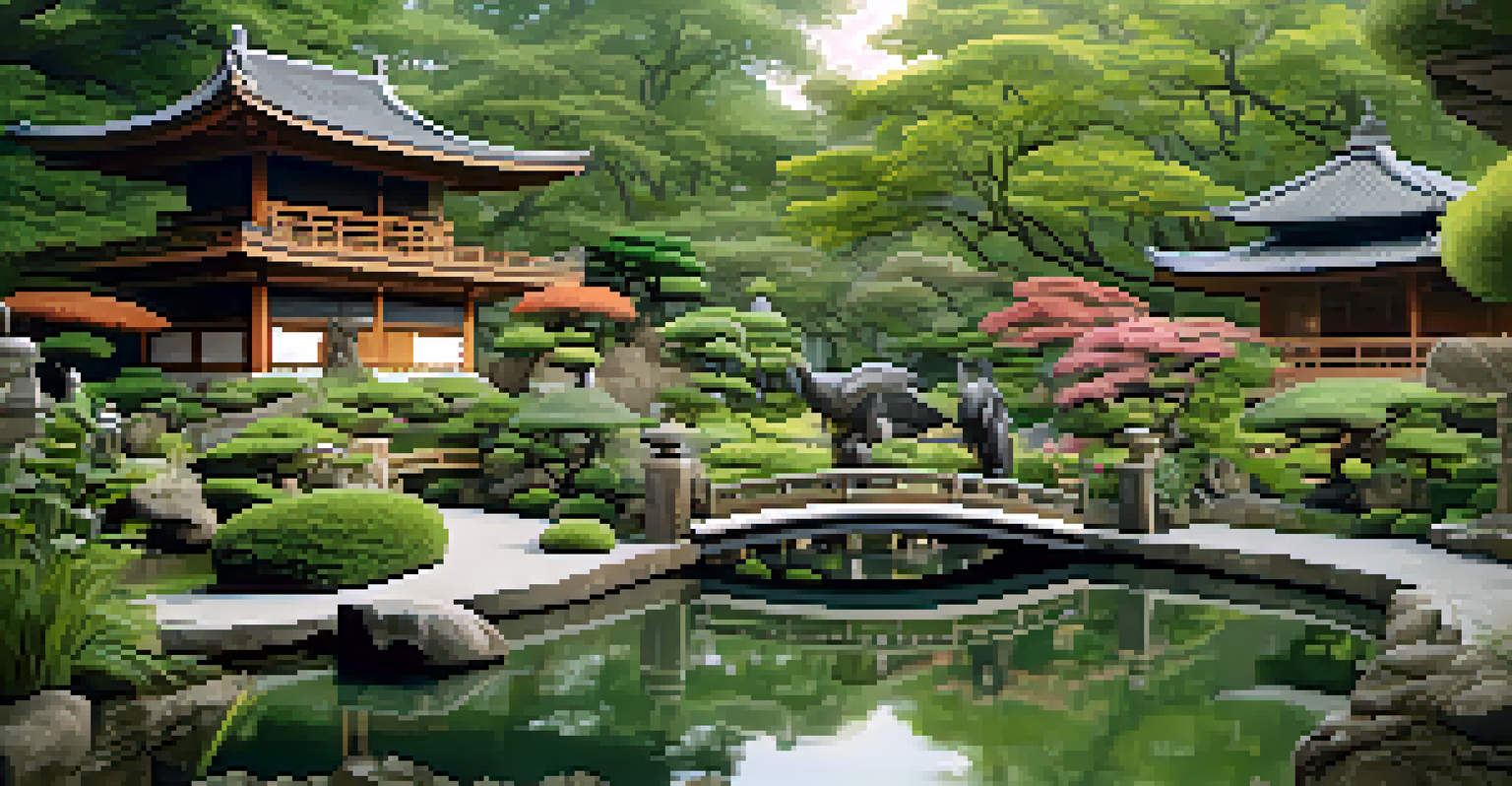Exploring the Intricate Wood Carving Techniques of Japan

A Brief History of Japanese Wood Carving
Japanese wood carving boasts a rich history dating back to ancient times, reflecting the cultural evolution of the nation. Initially, wood was used for practical purposes, such as constructing temples and shrines, but it soon became a canvas for artistic expression. Over centuries, these techniques evolved, intertwining with religious and aesthetic principles, leading to remarkable craftsmanship.
Art is a reflection of the culture and traditions that shape us.
During the Heian period, around the 8th century, the art of wood carving began to flourish, with artisans creating intricate figures and decorative elements for Buddhist temples. This period set the groundwork for the distinct styles that would emerge later, emphasizing both beauty and spiritual significance. As time progressed, the craft became a revered tradition passed down through generations.
Today, Japanese wood carving is not just a craft but a living heritage, with artisans dedicated to preserving these age-old techniques. Each piece tells a story, embodying the spirit of the era it belongs to while adapting to modern influences. This balance between tradition and innovation is what makes Japanese wood carving so captivating.
The Tools of the Trade: Essential Carving Instruments
To truly appreciate Japanese wood carving, it's important to understand the tools used by artisans. Traditional carving tools include chisels, knives, and gouges, each meticulously designed for specific tasks. For instance, the 'nomi' chisel is a favorite among woodworkers for its precision and ability to create intricate details.

Artisans often handcraft their tools, ensuring that each instrument feels just right in their hands. This personal touch not only enhances the quality of the work but also strengthens the bond between the craftsman and their tools. The choice of wood is equally crucial; popular types like cherry and cedar are favored for their durability and beauty.
Rich History of Wood Carving
Japanese wood carving has evolved from practical uses to a revered artistic tradition that reflects the nation's cultural heritage.
Using these tools, artisans can create stunning shapes and textures, transforming simple wood into intricate art. The mastery of these instruments is a testament to the skill and dedication involved in the craft, making every carving a unique representation of the artist's vision.
Key Techniques: Understanding the Craftsmanship
Japanese wood carving encompasses various techniques, each contributing to the overall artistry of the piece. One of the most notable methods is 'sumi-ita,' which involves incising designs into the surface of the wood. This technique creates depth and texture, making the patterns come alive.
Wood carving is not just a craft; it's a living heritage that tells the story of our past and inspires future generations.
Another popular technique is 'kakebuki,' where thin layers of wood are carefully removed to create intricate designs. This method requires a steady hand and a keen eye, as each cut must be precise to achieve the desired effect. The result is a stunning interplay of light and shadow that adds dimension to the artwork.
These techniques, along with many others, showcase the remarkable talent of Japanese wood carvers. Each method has its own charm and narrative, allowing artisans to express their creativity while honoring the traditions that have come before them.
Cultural Significance of Wood Carving in Japan
Wood carving in Japan is deeply intertwined with the country's culture and spirituality. Many carvings are created for religious purposes, such as statues of Buddha or intricate temple decorations, symbolizing devotion and reverence. This connection to spirituality elevates the craft beyond mere aesthetics, making each piece a sacred representation of faith.
Moreover, wood carving reflects the harmony between nature and humanity that is central to Japanese philosophy. The materials, often sourced from local forests, connect artisans to their environment, emphasizing sustainability and respect for nature. This relationship is evident in the way designs often mimic natural forms, such as animals or plants.
Cultural and Spiritual Significance
Wood carving in Japan embodies a deep connection to spirituality and nature, making each piece a sacred representation of faith and heritage.
As a result, wood carving is not just an artistic expression but a cultural narrative that honors Japan's heritage. It preserves stories from the past while continuing to inspire future generations, bridging the gap between tradition and modernity.
The Role of Modern Technology in Wood Carving
While traditional techniques remain at the heart of Japanese wood carving, modern technology has begun to play a role in this ancient craft. Tools like laser cutters and CNC machines can enhance precision, allowing artisans to experiment with new designs that were once difficult to achieve by hand. This integration of technology opens up new possibilities for creativity.
However, many artisans are cautious about relying too heavily on technology, fearing it may overshadow the personal touch that defines their work. Striking a balance between tradition and innovation is crucial, as it allows for the preservation of age-old skills while embracing contemporary advancements. This dialogue between past and present enriches the craft.
Ultimately, modern technology serves as a tool for enhancement rather than a replacement for traditional methods. By blending these approaches, artisans can create unique pieces that honor their heritage while appealing to a modern audience, ensuring that the art of wood carving continues to thrive.
Notable Japanese Wood Carvers and Their Works
Throughout history, many talented wood carvers have emerged from Japan, each contributing their unique style and perspective to the craft. One of the most renowned figures is Unkei, a 12th-century artist whose exquisite Buddhist sculptures set a high standard for craftsmanship. His attention to detail and lifelike expressions brought spiritual figures to life in a way that resonated deeply with viewers.
In more recent times, contemporary artists like Shiro Kuramata have pushed the boundaries of traditional wood carving. Kuramata's innovative designs blend modern aesthetics with traditional techniques, creating pieces that challenge conventions while paying homage to the past. His work exemplifies how wood carving can evolve while retaining its cultural significance.
Balancing Tradition with Innovation
Modern technology is enhancing traditional wood carving techniques, allowing artisans to blend age-old skills with contemporary creativity.
These artisans and their creations serve as inspiration for both aspiring and established wood carvers. By studying their techniques and philosophies, new generations can learn to appreciate the art form's depth and complexity, ensuring that the legacy of Japanese wood carving continues for years to come.
Preserving the Art of Japanese Wood Carving
As with many traditional crafts, preserving the art of Japanese wood carving is vital for cultural heritage. Various organizations and schools are dedicated to teaching these skills to younger generations, ensuring that the techniques and knowledge are not lost over time. Workshops and apprenticeships provide hands-on experience, allowing students to learn directly from skilled artisans.
Furthermore, exhibitions and cultural festivals play a significant role in showcasing the beauty of wood carving to a broader audience. These events celebrate the craftsmanship and creativity of artisans, fostering appreciation for the art form and encouraging a new wave of interest. This visibility helps sustain the craft and attract fresh talent.

Ultimately, the commitment to preserving Japanese wood carving reflects a deep respect for tradition and a desire to share its beauty with the world. As more people become engaged with this art form, the future of Japanese wood carving looks promising, blending tradition with innovation for years to come.